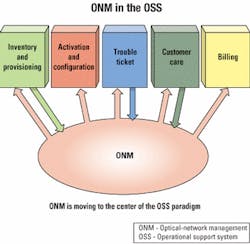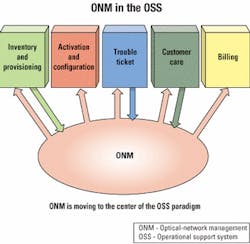ONM sheds light on optical networks
Optical networks present new challenges and opportunities to network management.
MARK BOURGEOIS, Clear Optical Network Management
Service providers have been at the center of the telecommunications storm for the last few years. While the recent challenge was to adopt and deploy the fastest, highest-bandwidth optical systems available as quickly as possible and help drive their development, market conditions (not to mention investors) now dictate a more conservative approach.
The current lull in the race can be used to advantage, if carriers use it to learn how to best leverage their existing assets before the inevitable next phase of build-out begins. Budgetary constraints and reductions in capital spending are in fact working to ensure that happens; without new capital investments, carriers are forced to do more with less. Thus, the immediate focus has shifted dramatically from network build-out to maximizing current investments. This shift has magnified the importance of the role of optical-network management (ONM).
Maximizing capital investment in existing network hardware means ensuring it delivers maximum performance and assiduously guards against outages. Though recently, carriers could afford to merely passively monitor the network for major faults and throw bandwidth at anything less, a more engaged approach is now needed. This approach will not only enable carriers to make the most of their current network, but by doing so, also ensure that future technology expenditures will be made only when genuinely necessary.
As such investments again become necessary, the ONM system should stand ready to integrate and seamlessly manage these new optical systems as well. In the meantime, ONM can help unify and manage the networks of providers that were left on the lurch in mid-build-out with a mix of optical and legacy elements.
The challenge for providers, and implicitly, for ONM, is twofold: to provide the functionality necessary to efficiently and comprehensively manage the network, and at the same time, keep pace with rapidly developing network technologies and protocols to continue to provide and enhance these functions as the network evolves. ONM is thus a uniquely suited component to both current and future needs of service providers and will be of increasing importance in the future.
What exactly is ONM? The Telemanagement Forum's Telecom Operations Model organizes network-management processes into a three-by-three framework consisting of fulfillment, assurance, and billing functions at network, service, and customer levels. Regardless of the technological implementation of the network, the basic business drivers for network management remain the same. According to this model, functions that must be performed in any network environment are to turn service up, ensure that it stays up, and then bill for it. Optical networks are in principle no different, although they do present new challenges in executing these functions.Since their principal function is to monitor the network, ONM systems are rooted in the network and service assurance arenas and encompass fault and performance management. These systems communicate directly with network elements or their dedicated element-management systems and collect data in real time on the health and status of the network. The information gathered by ONM systems is of three basic types: performance and error statistics, fault alarms and events, and resource utilization information such as autonomous route changes.
In fact, in the latest generation of optical networks, so many important things are happening in the network that would otherwise be invisible that today's ONM systems are expanding beyond the borders of service assurance to touch virtually every aspect of network management. They provide vital inputs to inventory, customer care, and even billing systems (see Figure 1).
Operational support systems (OSSs) depend on what the network is doing and how well it is performing. Billing systems need to know if service-level agreements (SLAs) are being met and if rebates are due. Inventory systems must be aware of route changes in the network, and customer service should proactively contact customers when problems occur on their lines.
To accomplish this last task, ONM systems may interface directly with a pro vider's network inventory system. In doing so, they are able to add critical context to the information the network provides: the end-to-end circuits and even particular customers who use them. The best ONM systems today have a customer-centric approach from the ground up, giving visibility not simply from the standpoint of the technician or network operations center operator, but also from that of the end user. That is a distinct departure from the network-management systems of old, which had a network- or element-centric approach.
Customer satisfaction is one of the most immediate and obvious benefits when ONM is used properly. The level of fault and performance management enabled by ONM allows a higher-quality product to the end user, with fewer data errors and higher availability.
Business customers especially rely on their communications services for basic day-to-day functioning. When services are down, there is an immediate and very high cost to the business, ranging from thousands to hundreds of thousands of dollars per hour. Increasingly, as businesses become more Internet- and information-oriented, outages can literally bring a business to a standstill. That's why customers consistently rate "lack of outages" as their number one priority.
The vast majority of hard outages, over two-thirds by many counts, are preceded by an increasing error rate. In other words, equipment usually gives signs of an impending hardware failure-if anyone is listening. By collecting and trending performance data on each network span, service providers can spot and fix degradations before they develop into full-blown outages, thereby ensuring they never actually do.
Line errors also take their toll. When hard outages occur and protection facilities function properly, the impact from the customer's point of view may be relatively minimal. But consistent line errors, requiring retransmission of data and loss of packets, can be even more pernicious. These errors may be at a level too small to trigger a protection switch but large enough to cause substantial problems. However, they are not too small to go unnoticed by the ONM, which provides a configurable threshold alert that triggers a network alarm when error rates rise to that level. In fact, one of the strengths of a customer-centric ONM is that because it is aware of and can monitor end-to-end circuits on a per-customer basis, it allows carriers to view things just as the customer does. Therefore, when errors or even outages occur, the provider can demonstrate exemplary customer service by contacting the customer before they contact the provider, giving confidence that things are under control and work is underway.To that end, ONM provides powerful tools to quickly troubleshoot and restore normal service to the circuit as fast as possible. End-to-end graphical circuit visualization, depicting every node and transport involved in the service, overlaid with real-time fault and performance data from the network, is a formidable aid to troubleshooting, especially in complex network environments (see Figure 2). Real-world applications of current ONM products have observed a 75% reduction in meantime-to-repair, with the number of problem incidents down by nearly an order of magnitude, by using such monitoring features instead of a manual approach.
The capabilities of a good ONM not only keep existing customers happy, but also allow for new-product offerings. Having control over network performance gives the carrier a critical new degree of freedom to compete in the marketplace. Rather than competing solely on price, a carrier with a fully implemented ONM can compete on service quality as well.
The critical issue facing most telecom service providers is how to differentiate from the competition. Some competitively position themselves strictly on price. Although this strategy may offer temporary success, competitors are likely to quickly match discounts. Moreover, if all providers compete strictly on price, profit margins will disappear-a phenomenon already seen in many telecom market segments.
Beyond price, differentiation can be based on product capabilities or service quality. In telecommunications, however, product capabilities generally come from network technology, which is readily available to all competitors. That ensures any lead in product will be short-lived at best. Therefore, service quality is the best way for a telecom service provider to achieve a sustainable competitive advantage.
This service quality can be "productized" as an SLA agreement. At a basic level, SLAs are being increasingly demanded by customers as a "warranty" of sorts on the product they are purchasing. ONM allows the provider to go beyond basic bare-bones SLAs to offer premium managed services of up to "seven-nines" availability. Some service providers have found that the market will bear at least a 25% price premium for the highest-level service and availability guarantees. In this way, ONM can help safeguard a provider's bottom line, even in the current environment (see Lightwave, April 2001, "Managing SLAs in today's optical networks," p. 149).
The implementation of any major system requires a cost/benefit analysis. Many benefits are associated with implementing an ONM, but what are the additional costs involved in administrating a network with ONM?
Fact is that ONM can substantially reduce network operations costs. The tools it provides are powerful enough to not only manage the network more closely, but also more efficiently. The same features that make trouble shooting easier and faster, such as circuit visualization with fault overlay and real-time streaming performance data to nail down intermittent problems, also increase technician productivity, reducing workload, overtime, and the total number of technicians required per network or customer. Likewise, such intuitive tools may potentially reduce the requisite skill level of the average technician, freeing up experienced techs for the most demanding work.
The proactive maintenance that ONM enables is also less expensive than reactive management for a number of reasons. First, it reduces or eliminates rebates that would otherwise be paid for SLA violations or outages. Second, it reduces the number of truck rolls, since repair work can be scheduled to coincide with routine maintenance instead of as an immediate response to a problem. Third, it reduces hardware sparing requirements for many parts, since failure-trend warnings allow time for parts to be transported from a central repository, instead of having redundant inventory located at each site in case of emergency. Finally, many carriers are also customers of other carriers. Many service providers, notably CLECs and wireless providers, lease capacity from other providers for at least some of their network. Implementing ONM on these links enables them to manage their suppliers as well, ensuring the same benefits they provide for their end customers, including any SLA rebates that are due. Although there is obviously an initial cost to implement an ONM system, it is likely to be recouped in a reasonably short period of time, and total cost of ownership is extremely low.
Cost savings may also be realized by gaining the ability to ease the integration of new network technologies into a provider's portfolio. By providing a preexisting, standards-based framework for monitoring performance and behavior of new network elements, the burden of their installation and initialization is significantly eased. ONM enables optimal use of existing resources, allowing providers to assess when additional resources are required, then provides a foundation to help integrate and manage the new assets when implemented.
ONM provides carriers visibility into their network and how it is functioning from end to end, enabling proactive rather than reactive network management. Carriers that implement ONM are able to do three critical things: increase customer satisfaction, retention, and recruitment; profitably offer new products such as SLA guarantees and premium services; and reduce operating expenses.
InfoTech in a June 2001 report, "OSS Opportunities in the Changing CLEC Market," states, "The competitive local-exchange carriers who remain standing after the market shakeout will share the common trait of using OSS effectively to strengthen their bottom lines."
The challenges for service providers have rarely been greater. But then, neither have the opportunities.
Mark Bourgeois is marketing engineer at Clear Optical Network Management (Lincolnshire, IL).


